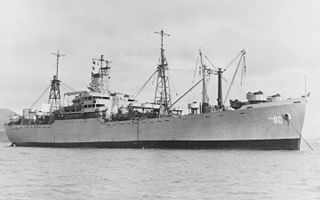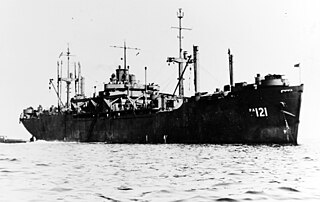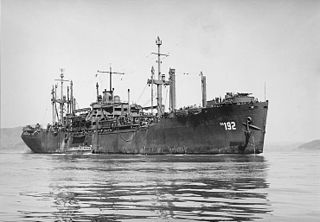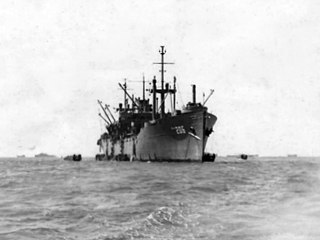Service history
Late in September, a naval officer recognized her potential for emergency service as a net cargo ship; and, on 1 October 1943, she was acquired under bareboat agreement from WSA and placed in service as Zebra (IX-107). It was the only ship of the Navy to bear this name. Her subsequent success in that role prompted her complete conversion to a net cargo ship and her total rehabilitation to operable status. On 15 February 1944, redesignated AKN-5, Zebra was placed in commission on 27 February 1944, while in drydock at Espiritu Santo. The ship was one of six ships and one of four Liberty types converted to net transports.
Salvaging net gear, 1944
During the first three months of her commissioned service, Zebra remained at Espiritu Santo, completing her partial conversion to a net cargo ship. She began her first mission on 1 June, when she started loading a cargo of reclaimed net material and put to sea on 8 June, bound for New Caledonia. The ship arrived in Nouméa, on 11 June, unloaded her net material, and took on a general cargo destined for the Fiji Islands. She departed Nouméa, on 19 June, arrived at Suva, three days later, unloaded, and began taking on reclaimed net material. On 27 June, she moved to the other side of the island where she began loading material salvaged from the Nandi net installations. The ship completed loading on 5 July, and headed back to New Caledonia, that same day. Zebra entered Nouméa, on 8 July, and discharged her load of salvaged net gear. Following 10 days at Nouméa, the net cargo ship embarked upon a circuit of various South Pacific islands to collect nets and equipment salvaged from the harbor defense installations. Through the remainder of the summer, the ship visited Tongatapu; Bora Bora; Tutuila and Upolu, Samoa; and Funafuti. At each island, she stopped long enough to unload part of the general cargo she had taken on at Nouméa, and pick up each installation's salvaged net gear. She departed her last port of call on that voyage, Funafuti, in the Ellice Islands, on 23 August, and returned to Nouméa, five days later.
Palau Islands
Zebra remained at Nouméa, until 15 September. On that day, she embarked upon a voyage which took her closer to war and which brought her first actual net-laying mission. The ship arrived in Eniwetok Lagoon, on 24 September, and remained there until 3 October, when she continued on toward the Western Carolines. Reaching Ulithi Atoll, on 8 October, the net cargo ship immediately began installing net gear around the anchorage with two of her sister ships, Sagittarius (AKN-2) and Tuscana (AKN-3). They completed their mission by 10 November, and Zebra loaded the unused net material for transportation to the Palaus. She departed Ulithi, that same day, and entered Barnum Bay, near Peleliu, two days later. While the fighting on Peleliu continued, the net cargo ship assembled a net installation for the protection of a wharf about to be constructed at the island. She concluded that portion of her mission on 14 November, and headed north in company with two net tenders to the anchorage at Kossol Roads. There, she spent 11 days assembling over two miles of net and supporting equipment. At the conclusion of that assignment, Zebra received orders to Pearl Harbor. She departed the Palaus, on 25 November, stopped at Eniwetok, briefly on 4 December, and arrived in Hawaii, on 15 December. At Pearl Harbor, she underwent 20 days of repairs and modifications before loading net gear in preparation for her next mission.
Iwo Jima, 1945
She remained at Pearl Harbor, through the end of January 1945, awaiting sailing orders. Finally, the ship got underway on 5 February, bound for Iwo Jima. She stopped at Eniwetok, between 16 February and 21 February, and then continued her voyage. Two days out of Eniwetok, Zebra's convoy received orders changing its destination from Iwo Jima, to Saipan, in the Marianas. Zebra, two net tenders, and a destroyer, however, received instructions to continue on to their original destination as a result of battle damage to her sister ship Keokuk (AKN-4). The little task unit arrived off Iwo Jima, on 28 February, and Zebra immediately began double duty, laying nets and serving as flagship for all minecraft in the vicinity. She stayed at Iwo Jima for 42 days, laying nets in spite of adverse weather, heavy seas, and fire from the enemy garrison. She also superintended the laying of ship moorings and performed several salvage jobs including pulling Zuni (ATF-95) and LST-727 off the Iwo Jima beach.
California
Zebra concluded her tour of duty at Iwo Jima, on 11 April, and shaped a course back to Eniwetok, where she arrived on 18 April. Continuing east, the ship entered Pearl Harbor, on 28 April, for a four-day layover before resuming her voyage to the West Coast. On 11 May, the net cargo ship arrived in San Francisco, California, to complete her conversion to a net cargo ship. She entered the Oakland yard of the Moore Dry Dock Company on 14 May. Work continued until mid-July when she received orders to participate in net laying experiments at Tiburon, California. Though speeded up, her conversion had not been completed when she slipped her moorings on 25 July, to join the operations up the bay at Tiburon. That duty lasted until 3 August, at which time the ship returned to Moore Drydock Co. to complete the remaining conversion work. On 26 August, she made her post-conversion, full power trial run and, soon thereafter, received orders assigning her to the Administrative Command, Minecraft, located at Pearl Harbor.
Post-war activities, 1945–1946
The ship stood out of San Francisco Bay, on 31 August, and arrived in Pearl Harbor, on 8 September. She remained in Hawaii only 12 days. On 20 September, she headed back to the western Pacific to collect salvaged net equipment. Carrying a small cargo of mine gear for the Marshall Islands command, she steamed to Kwajalein, where she arrived on 30 September, and unloaded her cargo before proceeding on to Iwo Jima. Zebra arrived at the latter island on 9 October, loaded net gear, and then headed for the Marianas, on 29 October. The ship made port at Saipan, on 1 November, unloaded the salvaged net equipment at the Saipan stockpile, and began loading passengers and equipment for return to the United States.
She departed Saipan, on 15 November, and stopped at Guam, on 16 November. There, she unloaded some mine-sweeping gear before resuming the voyage on 29 November. Steaming by way of Pearl Harbor, Zebra arrived at Pear Harbor, on 11 December, and departed on 13 December, for the Canal Zone, arriving there on 31 December 1945. Routed on to Norfolk, Virginia, she reported to the Commandant, 5th Naval District, on 8 January 1946.


















